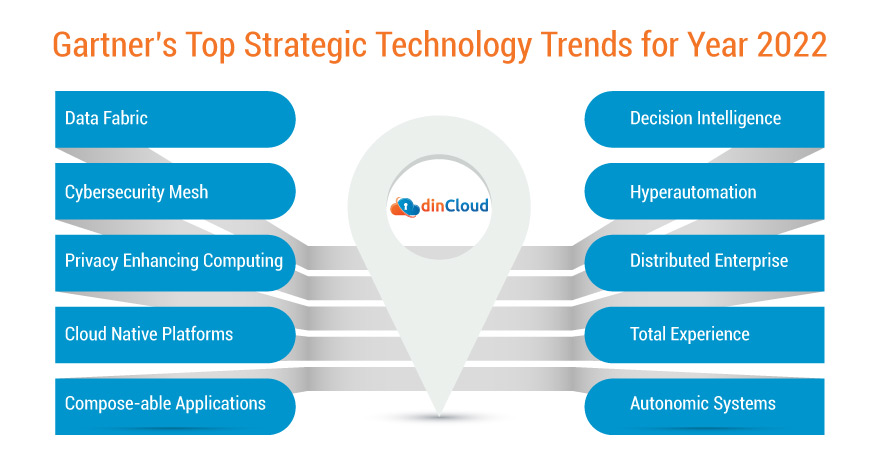As soon as businesses set foot into the last quarter of the calendar year, they start gearing themselves up for the next year, and the challenges that it holds. This year, and the following year 2022, will be all about recovery and consolidation.
In this challenging journey, digitalization and digital first technologies like Cloud Computing will continue to play a decisive role. The next year will be dominated by companies that adopt agile digital technologies, and align them with their business goals.
Research giant Gartner has made this seemingly tough task a whole lot easier, by listing its top strategic technology trends for 2022. Enterprises that adopt these trends will put themselves at a competitive advantage as compared to their counterparts.

In this post, we will briefly discuss some of the most notable digital technologies and trends pointed out by Gartner.
Data Fabric
As the physical boundaries of the enterprise fade away, data will also follow the same trend. So, it is imperative that enterprise IT infrastructures are envisioned and executed around efficiency as well as resilience, without compromising on security.
Related: Governments to Spend More on their IT Operations – Gartner
Cybersecurity Mesh
As the variety of IT infrastructures increases, so does the need to develop flexible cyber security solutions around it. These cyber security mechanisms will have to be intelligent, and contextually aware to deliver security, without compromising on productivity.
Privacy Enhancing Computing
Enterprises are under a two fold pressure in terms of data collection and processing. One part of this issue relates to compliance, while the other relates to customer privacy. So, insights from data will have to be extracted, with zero tolerance for weak privacy.
Cloud Native Platforms
Whether its legacy enterprise solutions or the latest ones, they will have to be designed in a way to ensure their maximum compatibility with various Cloud platforms. Developing cloud native solutions will exponentially increase cloud adoption success rates as well.
Related: The Crux of Gartner’s 2021 Hype Cycle for the Cloud
Compose-able Applications
Modern enterprise applications will have to be developed as microservices, rather than a monolithic block of code. This will make modern day enterprise applications agile and adaptive to developing business scenarios, while ensuring the re-use of code as well.
Decision Intelligence
These solutions aim to incorporate some degree of automation in organizational decision making. This will be made possible by leveraging historical trends, data analytics and simulation models. The outcome will be a structured approach towards decision making.
Related: Gartner Expects Digitalization Led Economic Recovery in 2021
Hyperautomation
This technology is all about a constant drive to identify processes within the enterprise that can be automated. This will give the modern enterprise a much better capability to rapidly scale, maintain remote operations and improve business resilience amidst disruptions.
Distributed Enterprise
The journey towards a distributed enterprise will be truly realized by adopting digital first technologies that are geared towards remote work capabilities. This approach will also need to encompass the customers, and other key stakeholders like suppliers etc.
Total Experience
Now, it is no more about just the Customer Experience. Instead, the modern enterprise will have to incorporate employee experience, user experience and every other stakeholder’s experience that has even the slightest interface with the business in any way.
Related: [Gartner] Anticipates Rise in Use of Managed Mobility Services (MMS)
Autonomic Systems
Just like Sci-Fi movies, these systems will be constantly evolving, due to their situational and contextual awareness at all times. These systems will be capable of making real time tweaks to business decisions and processes, as the situation on ground take a turn.
Conclusion
At the end of the day, it will all boil down to how quickly and effectively enterprises adopt these trends. One thing that is equally important here is to align or integrate these modern digital technologies with the short, mid and long term goals of the enterprise.
Please feel free to Contact dinCloud for state of the art cloud solutions that will prove instrumental in achieving the successful adoption of digital technologies.


